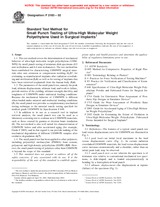We need your consent to use the individual data so that you can see information about your interests, among other things. Click "OK" to give your consent.
ASTM F2183-02
Standard Test Method for Small Punch Testing of Ultra-High Molecular Weight Polyethylene Used in Surgical Implants
STANDARD published on 10.4.2002
The information about the standard:
Designation standards: ASTM F2183-02
Note: WITHDRAWN
Publication date standards: 10.4.2002
SKU: NS-53112
The number of pages: 4
Approximate weight : 12 g (0.03 lbs)
Country: American technical standard
Category: Technical standards ASTM
Annotation of standard text ASTM F2183-02 :
Keywords:
mechanical behavior, miniature specimens, small punch test, UHMWPE, ultra-high molecular weight polyethylene, ICS Number Code 11.040.40 (Implants for surgery, prothetics and orthotics)
Additional information
| Significance and Use | ||||||||||||||||||
|
Miniature specimen testing techniques are used to characterize the mechanical behavior of UHMWPE stock materials and surgical implants after manufacture, sterilization, shelf aging, radiation crosslinking, thermal treatment, and implantation (1). Furthermore, experimental UHMWPE materials can be evaluated after accelerated aging and hip or knee wear simulation. Consequently, the small punch test makes it possible to examine relationships between wear performance and mechanical behavior of UHMWPE. This test method can also be used to rank the mechanical behavior of UHMWPE relative to a reference control material (such as the NIST Ultra-High Molecular Weight Polyethylene Reference Material #8456). Small punch testing results may vary with specimen preparation and with the speed and environment of testing. Consequently, where precise comparative results are desired, these factors must be carefully controlled. |
||||||||||||||||||
| 1. Scope | ||||||||||||||||||
|
1.1 This test method covers the determination of mechanical behavior of ultra-high molecular weight polyethylene (UHMWPE) by small punch testing of miniature disk specimens (0.5 mm in thickness and 6.4 mm in diameter). The test method has been established for characterizing UHMWPE surgical materials after ram extrusion or compression molding (1,2); for evaluating as-manufactured implants after radiation crosslinking and sterilization (3,4); as well as for testing of implants that have been retrieved (explanted) from the human body (5,6). 1.2 The parameters of the small punch test, namely the peak load, ultimate displacement, ultimate load, and work to failure, provide metrics of the yielding, ultimate strength, ductility, and toughness of UHMWPE under multiaxial loading conditions. Because the mechanical behavior of UHMWPE is different when loaded under uniaxial and multiaxial loading conditions (3), the small punch test provides a complementary mechanical testing technique to the uniaxial tensile testing specified for medical grade UHMWPE by Specification F 648. 1.3 In addition to its use as a research tool in implant retrieval analysis, the small punch test can be used as a laboratory screening test to evaluate new UHMWPE materials, such as those created by gamma or electron beam irradiation (1). The test method is also well suited for characterization of UHMWPE before and after accelerated aging (for example, Guide F 2003), and in that regard it can provide ranking of the mechanical degradation of different UHMWPE samples after oxidative degradation (4,7). 1.4 The small punch test has been applied to other polymers, including polymethyl methacrylate (PMMA) bone cement, polyacetal, and high density polyethylene (HDPE) (8,9). However, the small punch testing of polymers other than UHMWPE is beyond the scope of this standard. 1.5 This standard does not purport to address all of the safety concerns, if any, associated with its use. It is the responsibility of the user of this standard to establish appropriate safety and health practices and determine the applicability of regulatory limitations prior to use. |
||||||||||||||||||
| 2. Referenced Documents | ||||||||||||||||||
|
We recommend:
Technical standards updating
Do you want to make sure you use only the valid technical standards?
We can offer you a solution which will provide you a monthly overview concerning the updating of standards which you use.
Would you like to know more? Look at this page.




 Cookies
Cookies
